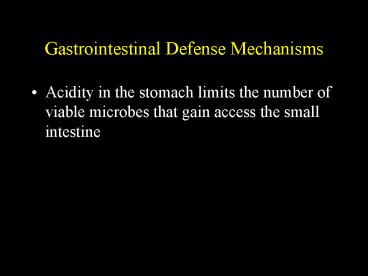Gastrointestinal Defense Mechanisms - PowerPoint PPT Presentation
1 / 28
Title:
Gastrointestinal Defense Mechanisms
Description:
Antibodies in colostrum provide the source of immune protection for newborn pigs ... During this time, colostrum immunoglobulins are absorbed across the intestinal ... – PowerPoint PPT presentation
Number of Views:381
Avg rating:3.0/5.0
Title: Gastrointestinal Defense Mechanisms
1
Gastrointestinal Defense Mechanisms
- Acidity in the stomach limits the number of
viable microbes that gain access the small
intestine
2
Gastrointestinal Defense Mechanisms
- Acidity in the stomach limits the number of
viable microbes that gain access the small
intestine - Non-immunologic defense mechanisms
- Intestinal biliary secretions (some microbes
sensitive) - Proteolytic enzymes can degrade bacterial cell
walls
3
Gastrointestinal Defense Mechanisms
- Epithelium serves as a barrier with tight
junctions between individual enterocytes forming
an epithelial monolayer that prevents the passage
of large molecules
4
Gastrointestinal Defense Mechanisms
- Epithelium serves as a barrier with tight
junctions between individual enterocytes forming
an epithelial monolayer that prevents the passage
of large molecules - Enterocytes on villi are replenished every 3 to 6
hours, this minimizes the opportunity for
successful colonization by potential pathogens
5
Gastrointestinal Defense Mechanisms
- Colonization resistance is the ability of
normal microbes to inhibit the colonization of
invading microbes in the intestine
6
Gastrointestinal Defense Mechanisms
- Colonization resistance is the ability of
normal microbes to inhibit the colonization of
invading microbes in the intestine - Inhospitable pH, nutrient competition,
competition for attachment sites, local
production of antibiotics called bacteriocins
7
Gastrointestinal Defense Mechanisms
- Colonization resistance is the ability of
normal microbes to inhibit the colonization of
invading microbes in the intestine - Inhospitable pH, nutrient competition,
competition for attachment sites, local
production of antibiotics called bacteriocins - Microhabitat communities are characteristic of a
species and to some extent the nutrition and
environment of the animal
8
Gastrointestinal Defense Mechanisms
- Germfree rodents (without normal gut bacteria),
all the immunologically important organs
(including intestine) are underdeveloped
9
Gastrointestinal Defense Mechanisms
- Germfree rodents (without normal gut bacteria),
all the immunologically important organs
(including intestine) are underdeveloped - Direct fed microbials enhance immunity and growth
in young pigs
10
Mucosal Immunology
11
Mucosal Immunity Pig Intestine
- Antibodies in colostrum provide the source of
immune protection for newborn pigs
12
Mucosal Immunity Pig Intestine
- Antibodies in colostrum provide the source of
immune protection for newborn pigs - Maximum immunoglobulin absorption occurs 4-12
hours after initial suckling and then declines
rapidly due to gut closure
13
Mucosal Immunity Pig Intestine
- Antibodies in colostrum provide the source of
immune protection for newborn pigs - Maximum immunoglobulin absorption occurs 4-12
hours after initial suckling and then declines
rapidly due to gut closure - During this time, colostrum immunoglobulins are
absorbed across the intestinal epithelium and
into lymphatic vessels
14
Mucosal Immunity Pig Intestine
- Serum antibodies have been detected as early as 3
hours after birth and can be similar to those of
the sow within 24 hours after birth.
15
Mucosal Immunity Pig Intestine
- Serum antibodies have been detected as early as 3
hours after birth and can be similar to those of
the sow within 24 hours after birth. - The initial antibody profile acquired via
colostrum is restricted to antigens to which the
sow has been exposed
16
Mucosal Immunity Pig Intestine
- Predominant immunoglobulin in colostrum is IgG
and while maternal IgG will protect against
systemic pathogens, pathogenic agents are
encountered at mucosal surfaces where IgG
antibodies are rarely found
17
GUT ASSOCIATED LYMPHOID TISSUE(GALT)
- One of the major subdivisions of the immune
system - 25 of intestinal mucosa is lymphoid tissue
18
GALT
- Major lymphoid compartments
- Lymphocytes are present between intestinal
epithelial cells lining the intesintal villus - Organized lymphoid follicles (Peyers patches)
- Scattered individual or small aggregates of
lymphoid follicles
19
Mucosal uptake of bacteria
- M cells are found in the epithelium overlaying
Peyers patches
20
Characteristic features of MALT
21
M cells facilitate antigen uptake.
22
M cells
- Originate from epithelial cells that are induced
to differentiate, contain few lysozomes and low
levels of phosphatase
23
M cells
- Originate from epithelial cells that are induced
to differentiate, contain few lysozomes and low
levels of phosphatase - Serve as a channel for entry of molecules into
the underlying mucosal follicular region
24
M cells
- Originate from epithelial cells that are induced
to differentiate, contain few lysozomes and low
levels of phosphatase - Serve as a channel for entry of molecules into
the underlying mucosal follicular region - Bacterial binding to M cells may be favored to
binding to other epithelial cells, (binding
events may be mediated by distinct surface
interactions)
25
Mucosal Immunology - Introduction
- Mucosal immunity protects internal epithelial
surfaces. - Components of the mucosal immune system include
lymphoid elements associated with internal
surfaces of the body (GI, respiratory,
urogenital) and exocrine secretory glands linked
to these organs, such as the salivary, lachrymal,
pancreas, and mammary glands.
26
Mucosa-associated lymphoid tissue (MALT)
Examples - Nasal-associated lymphoid tissue
(NALT). - tonsils, adenoids. - Gut-associated
lymphoid tissue (GALT). - Peyers patches. -
Bronchus-associated lymphoid tissue (BALT)
27
Oral Tolerance
- Oral tolerance is the generation of systemic
immune unresponsiveness by feeding of antigen.
The antigen is usually soluble and without
adjuvant or proinflammatory activity. - Oral
tolerance is likely a mechanism for prevention of
harmful immune responses to harmless antigens
such as foods. - A number of mechanisms may
underlie oral tolerance, including clonal
deletion, clonal anergy, or active suppression by
T cells (cytotoxic, TH2, or TGF-? producing)
28
ucosal Immunology- Lecture Outline -





























